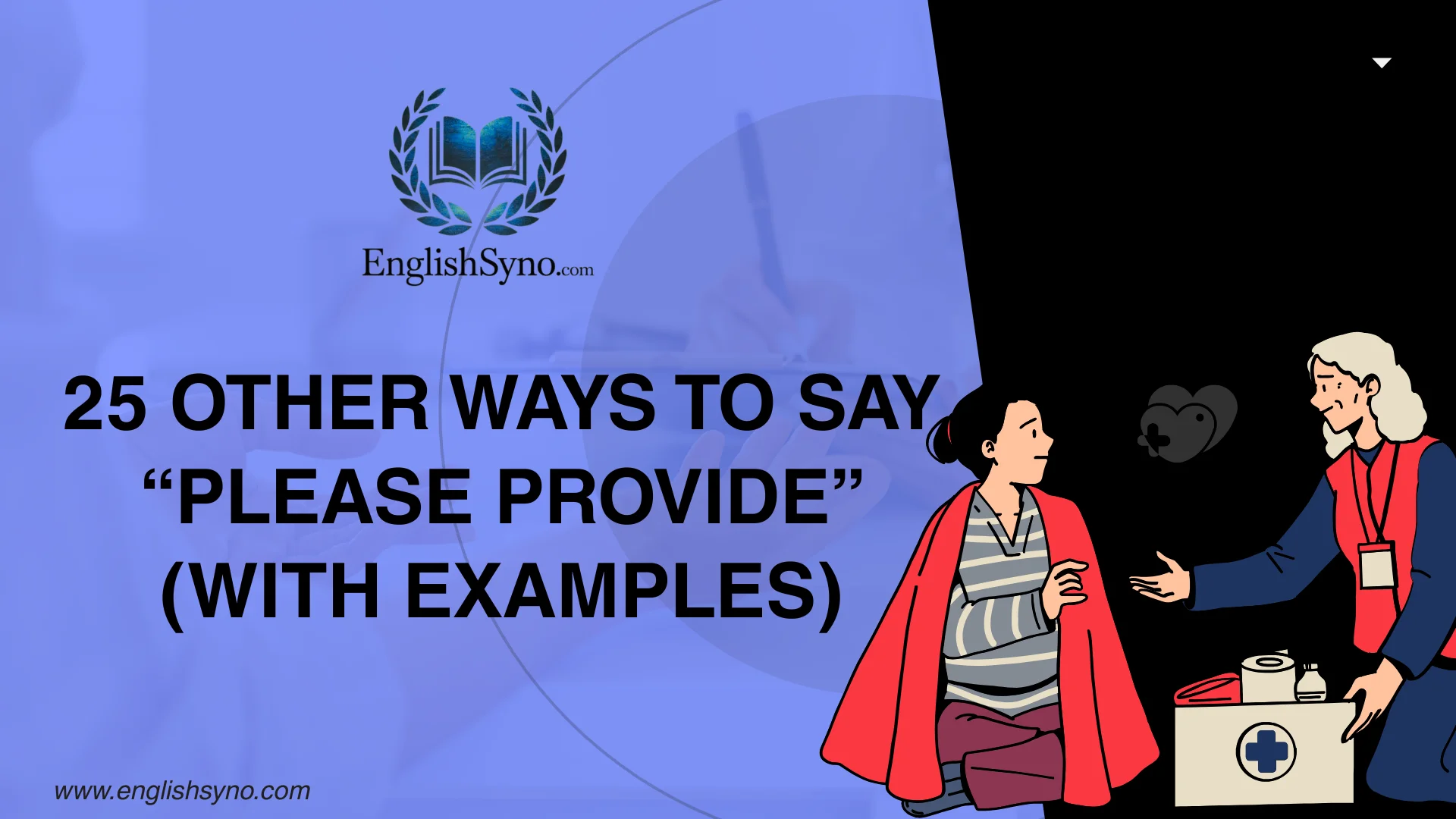When asking someone to please provide information or items, it’s important to do so politely and with courtesy, using clear phrases like “Could You Kindly Send Across” or “Can You Give” to make requests respectful and professional, adding convenience and showing consideration for the recipient while maintaining professionalism and effective communication.
In a professional setting, expressing requests courteously truly matters. There are 25 different ways to make such requests in workplace emails, and the best choice depends on personal preference or formality. Both “please provide” and “kindly send” are commonly used in English, suitable for emails, letters, official documents, and correspondence, helping ensure quick responses, correct handling, and smooth collaboration with colleagues, clients, or anyone else involved.
What Does “please provide” Mean?
“Please provide” is a courteous phrase used to request information, items, or assistance from someone. It conveys respect, politeness, and a professional tone, signaling that you expect the requested information while remaining considerate of the recipient.
When to Use “please provide”
Please use provide when you need someone to send details, submit documents, or share information in a professional or formal context. It works well in emails, letters, official documents, and workplace communications. Avoid overusing it in casual conversations where simpler language may be more natural.
Is It Professional/Polite to say “please provide”?
Yes, please provide is widely accepted as professional and polite. It demonstrates respect for the recipient’s time while clearly requesting what you need. Overusing it can sound formulaic, so mixing it with alternative phrases can keep your communication fresh and engaging.
Pros or Cons
Pros:
- Clear and polite
- Professional tone
- Widely understood
Cons:
- Can feel repetitive if overused
- It may seem overly formal in casual contexts
Could You Kindly Send
Meaning/Definition: A polite way to request someone to send documents, information, or items.
Detailed Explanation: This phrase conveys respect and consideration, and softens the request, making it feel less like a command.
Example Email: “Could you kindly send the Q3 reports by the end of the day?”
Best Use: Formal emails, requesting documents, or reports. Worst Use: Casual chats or informal requests. Tone: Polite, respectful, considerate
Can You Give
Meaning/Definition: A simple and direct way to ask for something from someone.
Detailed Explanation: Slightly less formal than “please provide,” but still professional and courteous when phrased politely.
Example Email: “Can you give me access to the shared project folder?”
Best Use: Workplace emails, brief requests. Worst Use: Very formal or legal documents. Tone: Friendly, approachable, courteous
Would You Mind Providing
Meaning/Definition: A softened, polite request that emphasizes the recipient’s choice in responding.
Detailed Explanation: It frames the request as considerate, showing that you respect the recipient’s time and effort.
Example Email: “Would you mind providing the updated client list before our meeting?”
Best Use: Emails where you want to sound especially courteous. Worst Use: Urgent requests that require immediate action. Tone: Respectful, gentle, thoughtful
Please Send Over
Meaning/Definition: A casual yet polite phrase for asking someone to transmit documents or files.
Detailed Explanation: It works well in emails and messages when sending over items or attachments is expected.
Example Email: “Please send over the presentation slides before tomorrow’s meeting.”
Best Use: Professional emails, internal communications. Worst Use: Formal legal or contractual requests. Tone: Polite, professional, approachable
Kindly Supply
Meaning/Definition: A formal phrase to request items or information politely.
Detailed Explanation: Suitable for professional letters, official communications, and formal workplace contexts. It emphasizes courtesy and professionalism.
Example Email: “Kindly supply the required documentation by Friday.”
Best Use: Official documents, HR requests, formal communications. Worst Use: Casual workplace chats. Tone: Formal, courteous, respectful
6. Attach
Meaning/Definition: Requesting someone to include or attach files or documents with their response.
Detailed Explanation: This phrase is direct yet polite, and is ideal when asking for files that need to be shared electronically.
Example Email: “Attach the revised budget spreadsheet for our review.”
Best Use: Emails requesting documents or files. Worst Use: Casual spoken requests. Tone: Professional, polite, concise
Forward
Meaning/Definition: Asking someone to send information or files onward.
Detailed Explanation: Often used for emails or documents that have already been received by the recipient and need to be sent to you.
Example Email: “Forward the client feedback from yesterday’s meeting.”
Best Use: Professional email correspondence. Worst Use: Informal verbal requests. Tone: Courteous, professional, direct
May I Request
Meaning/Definition: A polite phrase that formally asks for information or items.
Detailed Explanation: Softens the request, making it feel considerate while maintaining formality.
Example Email: “May I request the updated project timeline at your convenience?”
Best Use: Formal emails and letters. Worst Use: Instant messaging or casual emails. Tone: Polite, formal, respectful
Send Along
Meaning/Definition: Asking someone to share files or information by sending them.
Detailed Explanation: Friendly and professional, it encourages the recipient to share necessary materials efficiently.
Example Email: “Send along the draft proposal before our team call.”
Best Use: Workplace emails, team communication. Worst Use: Legal or highly formal documentation. Tone: Courteous, approachable, professional
Provide at Your Earliest Convenience
Meaning/Definition: Requests information urgently but politely, leaving the timing flexible.
Detailed Explanation: Shows urgency while respecting the recipient’s schedule, maintaining a courteous tone.
Example Email: “Please provide at your earliest convenience the monthly sales report.”
Best Use: Professional emails requiring timely information. Worst Use: Casual or instant requests where urgency is informal. Tone: Polite, professional, considerate
Give Access To
Meaning/Definition: Requesting someone to grant access to files, folders, or resources.
Detailed Explanation: Clear and direct, suitable for digital resources or restricted content.
Example Email: “Give access to the shared folder for the marketing team.”
Best Use: Workplace requests for digital access. Worst Use: Verbal requests without context. Tone: Professional, courteous, direct
Request Submission
Meaning/Definition: A formal way to ask for the submission of documents or forms.
Detailed Explanation: Often used in HR, administrative, or legal contexts.
Example Email: “Request submission of all project deliverables by Friday.”
Best Use: Official documents and compliance requests. Worst Use: Casual communication. Tone: Formal, professional, respectful
Share With Me
Meaning/Definition: A friendly, polite way to ask someone to provide information or files.
Detailed Explanation: Less formal than “please provide,” suitable for team collaboration.
Example Email: “Share with me the client presentation before the meeting.”
Best Use: Internal team communication, emails. Worst Use: Formal legal or contractual requests. Tone: Friendly, approachable, polite
Could You Provide
Meaning/Definition: A direct yet polite way to request information or items.
Detailed Explanation: Adds courteous phrasing with “Could you,” making the request professional and respectful.
Example Email: “Could you provide the quarterly performance data by Thursday?”
Best Use: Workplace emails and formal requests. Worst Use: Casual messaging with peers. Tone: Respectful, polite, professional
Kindly Send
Meaning/Definition: A polite, formal way to request files, documents, or information.
Detailed Explanation: Softens the request with “Kindly,” making it suitable for formal email communication.
Example Email: “Kindly send the updated client report at your earliest convenience.”
Best Use: Professional emails, client communication. Worst Use: Instant messaging or casual chats. Tone: Courteous, professional, polite
Would You Be Able To
Meaning/Definition: Polite inquiry asking if the recipient can provide information or resources.
Detailed Explanation: Slightly softer and more considerate than direct commands.
Example Email: “Would you be able to share the revised schedule before Monday?”
Best Use: Professional requests, polite inquiries. Worst Use: Urgent or time-sensitive commands. Tone: Respectful, gentle, professional
Submit
Meaning/Definition: A Formal term for sending or providing required items or documents.
Detailed Explanation: Often used in administrative or academic settings to request completed forms or work.
Example Email: “Submit your project report by the end of the week.”
Best Use: HR, legal, or academic submissions. Worst Use: Casual team communication. Tone: Formal, direct, professional
Pass Along
Meaning/Definition: Asking someone to transfer information or files.
Detailed Explanation: Informal but polite, suitable for internal communication.
Example Email: “Pass along the meeting notes to the new team members.”
Best Use: Internal communication, collaborative teams. Worst Use: Legal or highly formal documents. Tone: Friendly, courteous, professional
Hand Over
Meaning/Definition: A Direct, polite way to request physical or digital items.
Detailed Explanation: Slightly more formal than casual sharing, often used in professional settings.
Example Email: “Hand over the signed contracts to HR by Friday.”
Best Use: Office or formal professional context. Worst Use: Casual conversations. Tone: Professional, direct, polite
Make Available
Meaning/Definition: Requesting someone to provide access or items in a professional manner.
Detailed Explanation: Implies readiness and accessibility of the requested items.
Example Email: “Make available the financial reports for the audit team.”
Best Use: Formal workplace requests, resource sharing. Worst Use: Informal messaging. Tone: Professional, courteous, formal
Deliver
Meaning/Definition: Asking someone to provide items, information, or documents.
Detailed Explanation: Strong and direct, suitable for deadlines or official requirements.
Example Email: “Deliver the finalized design documents by Tuesday.”
Best Use: Workplace and project management contexts. Worst Use: Casual requests. Tone: Direct, professional, formal
Issue
Meaning/Definition: Official term to request provision of documents or approvals.
Detailed Explanation: Common in administrative, government, or HR communications.
Example Email: “Issue the official letters to all department heads.”
Best Use: Formal correspondence, administrative requests. Worst Use: Informal email threads. Tone: Formal, professional, authoritative
Grant
Meaning/Definition: Asking for permission or access to information, resources, or files.
Detailed Explanation: Polite, professional, and suitable when the recipient controls access.
Example Email: “Grant me access to the project database for analysis.”
Best Use: Requests for permissions or restricted access. Worst Use: Casual sharing without formality. Tone: Courteous, formal, professional
Provide Access
Meaning/Definition: Polite request to allow access to documents, systems, or resources.
Detailed Explanation: Common in workplace communication when sharing files or secured information.
Example Email: “Provide access to the updated client folder for the team.”
Best Use: Digital file sharing and internal requests. Worst Use: Informal spoken requests. Tone: Professional, courteous, clear
Facilitate
Meaning/Definition: A formal way to assist in providing or making available information or items.
Detailed Explanation: Emphasizes enabling or helping someone to provide what’s needed.
Example Email: “Facilitate the sharing of the latest project documents with all stakeholders.”
Best Use: Formal, professional, collaborative contexts. Worst Use: Casual team chat or informal emails. Tone: Formal, professional, courteous
Final Thoughts
Finding the right words to communicate requests is more than just etiquette—it reflects care, respect, and professionalism. Using “please provide” is clear and polite, but exploring alternatives allows you to express yourself thoughtfully while making messages feel more personal and engaging. Each phrase, whether it’s “Could You Kindly Send Across”, “Would You Mind Providing”, or “Kindly Supply”, carries subtle nuances in tone, urgency, and formality. Understanding these nuances ensures your communication is both effective and courteous, whether you are requesting documents, information, or access.
In professional settings, selecting the right phrase shows respect for your colleagues’ time, enhances collaboration, and can prevent misunderstandings. It also demonstrates that you are attentive to tone, considerate of context, and capable of maintaining professionalism across diverse interactions. Even in casual or internal communications, using the appropriate phrase can foster goodwill and efficiency.
Ultimately, mastering these alternatives equips you to adapt your requests to the situation, whether you are sending formal emails, internal messages, or quick file requests. By practicing these expressions and being mindful of tone, timing, and recipient context, your communication will stand out as polished, considerate, and effective, leaving a positive impression and promoting smooth collaboration across teams, clients, and stakeholders alike. Thoughtful phrasing transforms a simple request into an opportunity to convey professionalism and empathy, making your interactions more meaningful and impactful in every professional setting.
FAQs
What does “please provide” mean?
“Please provide” is a polite phrase used to request information, documents, or items professionally or courteously. It signals respect for the recipient while clearly stating what is needed.
Is “please provide” formal?
Yes, “please provide” is considered formal and professional, suitable for emails, letters, and official documents.
Can I use “please provide” in casual messages?
It can be used, but simpler alternatives like “send over” or “share with me” are usually more natural in casual contexts.
How is “Could You Kindly Send Across” different from “please provide”?
It is softer and more polite, adding warmth and emphasizing consideration for the recipient’s time and effort.
What are polite alternatives to “please provide”?
Alternatives include “Would You Mind Providing”, “Kindly Send”, “Attach”, “Forward”, “Make Available”, and “Provide at Your Earliest Convenience”.
When should I use “kindly send”?
Use “kindly send” in formal emails where you are requesting documents or information, particularly with clients or supervisors.
Can “please provide” sound demanding?
It can seem rigid if overused; pairing it with courteous phrases softens the tone and shows respect.
How do I make requests sound warm?
Use alternatives that show consideration, like “Would You Mind Providing” or “May I Request”, to convey warmth while maintaining professionalism.
Is “Attach” a professional request?
Yes, Attach is direct and professional when asking for documents or files via email.
Can I use “forward” for any document?
Yes, Forward works when the recipient already has the document and needs to send it to you.
What is the best tone for requesting information?
The best tone is polite, respectful, and clear, showing consideration for the recipient’s time and responsibilities.
How many alternatives to “please provide” are effective?
There are dozens, including formal, casual, and collaborative options, depending on context and urgency.
Does “please provide” work in team collaboration?
Absolutely. It maintains clarity and professionalism while ensuring requests are understood and actionable.
How can I choose the right alternative?
Consider formality, urgency, relationship with the recipient, and tone to select the most appropriate phrase.
Can these alternatives improve communication?
Yes. Thoughtful alternatives enhance clarity, respect, and professionalism, making requests easier to respond to and fostering positive relationships.



